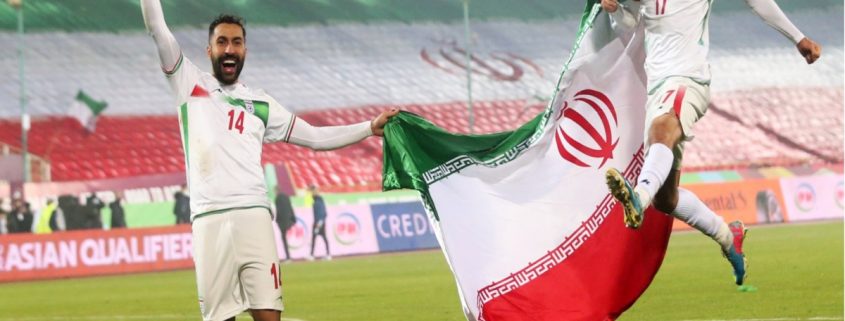Here’s what you need to know about Iran and the World Cup
By Evette Jahangiri
This article was first published on Muslim Girl
Before the United States’ match with Iran at the World Cup, the United States Soccer Federation soccer posted a photo of their flag icons on their Instagram page. There was something noticeably different about Iran’s flag. In the post, they replaced Iran’s current flag, as it was without the emblem of the Islamic Republic. The Iranian government reacted angrily to this, labeling it offensive and demanding that the US be removed from the game. The USSF was allowed to protest and let off with an apology, but Iranian fans attending the games were met with a completely different reaction.
THE CONTROVERSY BEHIND DEFACING FLAGS
Objectively speaking, changing any country’s flag is not okay, and anyone would be upset if they saw their flag being misrepresented. This would be equivalent to defacing a country’s national monument. The backlash was understandable – especially since the flag posted removed the tulip emblem that contained the name of Allah (SWT) and the phrase Allahu Akbar.
The decision to remove this symbol has Islamophobic undertones because of the flag’s design and symbolism. Some non-Muslims have expressed discomfort and misunderstanding at Arabic phrases and words Muslims use in relation to daily life activities. So, when ignorant people have an opportunity to disparage a language or a culture they don’t fully understand, they take it. We’ve seen this in many forms and places outside our community.
Kudos to the USSF for taking a stand and showing their support, but its execution could have been cleaner.
It does seem odd how the United States Soccer Federation, which claims to show support for women’s rights and women in Iran, would not post the pre-Islamic revolution flag on their social media. The original flag with the image of a lion carrying a sword with the sun rising in the back is distinct enough from the current flag to avoid confusion between the two. Meanwhile, the pre-Islamic revolution flag is a symbol of support for the protestors and is used in Iran. The switch would not have been difficult if they had done their research.
They obviously did not spend much time researching the issue since they admitted to only keeping the edited flag for 24 hours before restoring it to the original image. Since there was already a plan in place because they knew there would be an uproar, why not post the pre-revolution flag in the first place? Additionally, editing the flag and then restoring it later muddles the message they were attempting to send. It’s imperative to acknowledge this is a sensitive topic and that people are only willing to cross boundaries with limits to maintain some peace or tranquility. Kudos to the USSF for taking a stand and showing their support, but its execution could have been cleaner.
FLAGS- A VALID FORM OF PROTEST
While controversy remains around the edited symbol, using a flag can be a valid form of protest. Iran’s pre-Islamic revolution flag is a sign of protest against Iran’s current government and its heinous actions toward Iranian women. By carrying this flag and not the current one, it symbolizes defiance towards their government. It’s a theoretical or even literal representation of a time and place that Iranians remember and want back.
Iranian attendees at the World Cup are using the pre-Islamic revolution flag as a form of protest as well, but they’ve been met with different responses than the United States Soccer Federation. The United States was basically allowed off with an apology and changed the image of the flag. But the Iranian attendees of the World Cup were forced to remove items that contained images of the pre-revolution flag or contained language or phrases related to the protests. Also, Iranian fans have experienced conflict with other fans supporting the Iranian government. Many fans were threatened by security denying them entrance if they did not get rid of or hand over their protest material.
We use symbolism, images, and phrases to communicate what we are feeling when words aren’t enough.
This double standard of allowing certain groups or people to protest and not allowing others is discriminatory and defeats the purpose of solidarity. While allowing the United States Soccer Federation to protest and show their solidarity, Iranian attendees are not allowed to protest conditions of their own country. The irony is not lost on those who claim to be defenders of the right to protest against human rights violations in other countries. There seems to be an unwritten clause that states that those protests are only for countries that serve the interest of the United States.
Protests are controversial. It’s inherent in the very nature of the act. They are emotional and often fueled by frustration and even grief. We’ve seen and experienced protests of every form covering everything from mass school shootings to claims that elections were stolen. We use symbolism, images, and phrases to communicate what we are feeling when words aren’t enough. The use of symbols and imagery helps the movement catch on and is easier to share on social media. Taking this away from protestors hurts the movement and is a violation of freedom of speech.
SUPPRESSION OF PROTEST
Suppressing people from protesting translates into using protests for performative reasons instead of believing in the message and the people you are supposed to be supporting. It’s like marking something off your to-do list and moving on. For Iranian people this is not just a protest or just a flag – this is reality, and this affects real people.
Sure, Qatar has valid reasons for not allowing forms, symbols, or products of protest into their stadiums. They probably want to maintain the public health and security of fans. They want to leave a good impression on the world as the host country for the World Cup. They probably want to prevent any chance of them getting tangled up in controversy. There is a lot of pressure and work that goes into hosting any international event, especially when it comes to sporting events. So, it is only natural for Qatar to want everything to be perfect.
But is attempting to separate politics from sports by confiscating fans’ clothing or items the right move? Separating politics from sports is no longer possible. From Colin Kaepernick taking a knee to Tim Tebow praying on the field, sports are no longer immune to the world around them. Players are part of this climate and are affected by what happens. They are human after all.
Still, there is a large group who argue that involving politics taints the integrity of sports. Maintaining this divide is important because sports are supposed to be a source of entertainment and even an escape from reality for fans. To some extent I agree with them, sometimes all we want is an escape from our problems, even for a moment. But the world is constantly evolving, and I don’t see this dying down anytime soon.
While these incidents were unfortunate, we must continue to protest and show our support for the women in Iran. We need to continue creating momentum for this movement so the right messages are received by the world.





















2022
1,413 views
views
0
comments